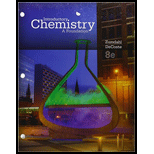
(a)
Interpretation: The given
Concept Introduction: When an atom on undergoing radioactive decay emits an alpha particle (helium nucleus, 42He) from the nucleus of an atom, then such type of radioactive decays is said to be alpha decay.
(a)
Answer to Problem 22QAP
Explanation of Solution
Given:
When an atom on undergoing radioactive decay emits an alpha particle (helium nucleus, 42He) from the nucleus of an atom, then such type of radioactive decays is said to be alpha decay.
The general reaction for alpha decay is:
Where A is mass number, Z is
The given atom is At-196.
The atomic number of At is 85. The alpha emission will result in decrease in number of protons by 2 so, the number of protons of the element formed from beta emission of At-196will be 83 and the mass number will decrease by 4 so, the mass number of elements is 196 − 4 = 192. The element with atomic number 83 is Bismuth, Bi. Thus, the complete nuclear reaction is:
(b)
Interpretation: The given nuclear equation should be completed.
Concept Introduction: When an atom on undergoing radioactive decay emits an alpha particle (helium nucleus, 42He) from the nucleus of an atom, then such type of radioactive decays is said to be alpha decay.
(b)
Answer to Problem 22QAP
Explanation of Solution
Given:
When an atom on undergoing radioactive decay emits an alpha particle (helium nucleus, 42He) from the nucleus of an atom then such type of radioactive decays is said to be alpha decay.
The general reaction for alpha decay is:
Where A is mass number, Z is atomic number (number of protons), and X is the symbol of element.
The given atom is Po-208.
The atomic number of Po is 84. The alpha emission will result in decrease in number of protons by 2 so, the number of protons of the element formed from beta emission of Po-208 will be 82 and the mass number will decrease by 4 so, the mass number of elements is 208 − 4 = 204. The element with atomic number 82 is Lead, Pb. Thus, the complete nuclear reaction is:
(c)
Interpretation: The given nuclear equation should be completed.
Concept Introduction: When an atom on undergoing radioactive decay emits an alpha particle (helium nucleus, 42He) from the nucleus of an atom then such type of radioactive decays is said to be alpha decay.
(c)
Answer to Problem 22QAP
Explanation of Solution
Given:
When an atom on undergoing radioactive decay emits an alpha particle (helium nucleus, 42He) from the nucleus of an atom, then such type of radioactive decays is said to be alpha decay.
The general reaction for alpha decay is:
Where A is mass number, Z is atomic number (number of protons), and X is the symbol of element.
The given atom is Rn-210.
The atomic number of Rn is 86. The alpha emission will result in decrease in number of protons by 2 so, the number of protons of the element formed from beta emission of Rn-210 will be 84 and the mass number will decrease by 4 so, the mass number of elements is 210 − 4 = 206. The element with atomic number 84 is Polonium, Po. Thus, the complete nuclear reaction is:
Want to see more full solutions like this?
Chapter 19 Solutions
Bundle: Introductory Chemistry: A Foundation, 8th + OWLv2 6-Months Printed Access Card
 Introduction to General, Organic and BiochemistryChemistryISBN:9781285869759Author:Frederick A. Bettelheim, William H. Brown, Mary K. Campbell, Shawn O. Farrell, Omar TorresPublisher:Cengage Learning
Introduction to General, Organic and BiochemistryChemistryISBN:9781285869759Author:Frederick A. Bettelheim, William H. Brown, Mary K. Campbell, Shawn O. Farrell, Omar TorresPublisher:Cengage Learning Introductory Chemistry: A FoundationChemistryISBN:9781337399425Author:Steven S. Zumdahl, Donald J. DeCostePublisher:Cengage Learning
Introductory Chemistry: A FoundationChemistryISBN:9781337399425Author:Steven S. Zumdahl, Donald J. DeCostePublisher:Cengage Learning Chemistry: The Molecular ScienceChemistryISBN:9781285199047Author:John W. Moore, Conrad L. StanitskiPublisher:Cengage Learning
Chemistry: The Molecular ScienceChemistryISBN:9781285199047Author:John W. Moore, Conrad L. StanitskiPublisher:Cengage Learning World of Chemistry, 3rd editionChemistryISBN:9781133109655Author:Steven S. Zumdahl, Susan L. Zumdahl, Donald J. DeCostePublisher:Brooks / Cole / Cengage Learning
World of Chemistry, 3rd editionChemistryISBN:9781133109655Author:Steven S. Zumdahl, Susan L. Zumdahl, Donald J. DeCostePublisher:Brooks / Cole / Cengage Learning Chemistry & Chemical ReactivityChemistryISBN:9781337399074Author:John C. Kotz, Paul M. Treichel, John Townsend, David TreichelPublisher:Cengage Learning
Chemistry & Chemical ReactivityChemistryISBN:9781337399074Author:John C. Kotz, Paul M. Treichel, John Townsend, David TreichelPublisher:Cengage Learning Chemistry & Chemical ReactivityChemistryISBN:9781133949640Author:John C. Kotz, Paul M. Treichel, John Townsend, David TreichelPublisher:Cengage Learning
Chemistry & Chemical ReactivityChemistryISBN:9781133949640Author:John C. Kotz, Paul M. Treichel, John Townsend, David TreichelPublisher:Cengage Learning





